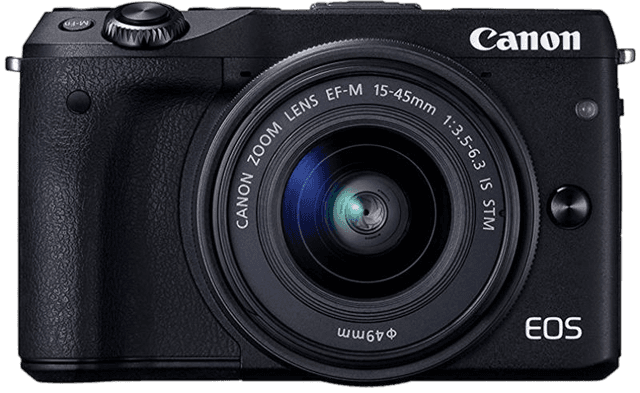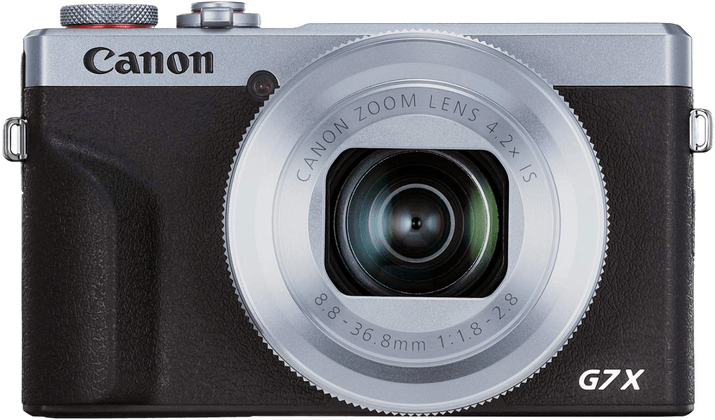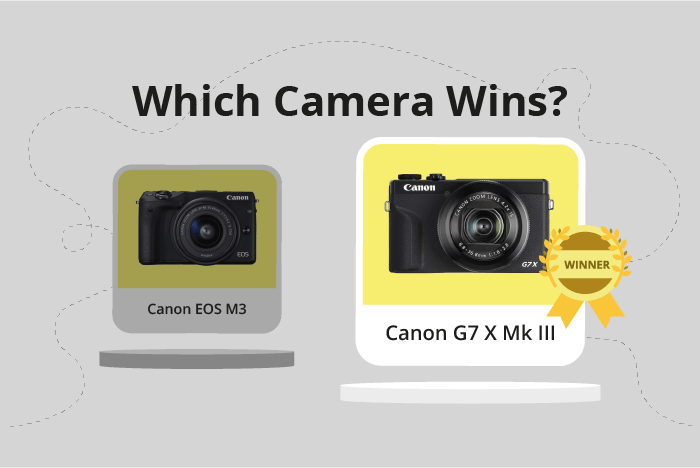Canon EOS M3 vs PowerShot G7 X Mark III Comparison
Canon EOS M3

Canon PowerShot G7 X Mark III

The Canon PowerShot G7 X Mark III wins this comparison with a score of 59/100, while the Canon EOS M3 scores 56/100. Both cameras share similarities, such as their announcement in the 2010s and their similar sizes. The PowerShot G7 X Mark III is better due to its more recent release in 2019, which makes it a more advanced camera. It also has a lower launch price of $749 and is lighter, weighing only 304g.
On the other hand, the EOS M3, released in 2015, has a higher launch price of $870 and weighs 366g. Despite these disadvantages, it remains a decent camera option for those preferring a mirrorless camera type. When considering each camera’s specifications, the PowerShot G7 X Mark III stands out as the better choice due to its advanced features, lower price, and lighter weight.
Canon EOS M3 vs PowerShot G7 X Mark III Overview and Optics
The Canon EOS M3 takes the lead in optics, scoring 60/100, while the Canon PowerShot G7 X Mark III trails slightly behind with a score of 57/100. Both cameras share some specifications, including a CMOS sensor and a similar shooting speed (4.2 for the EOS M3 and 30 for the G7 X Mark III).
The EOS M3 outshines the G7 X Mark III with its higher megapixel count (24.2 vs. 20), larger sensor size (APS-C vs. 1″), and better DXOMARK score for the sensor (72 vs. 58). Additionally, the EOS M3 features a Canon EF-M lens mount, providing users with the flexibility to change lenses as needed.
On the other hand, the PowerShot G7 X Mark III has its own advantages. It boasts a more advanced processor (Digic 8 vs. Digic 6) and offers image stabilization, a feature lacking in the EOS M3. However, the G7 X Mark III uses a fixed lens mount, limiting users to the built-in lens.
Considering these factors, the Canon EOS M3 emerges as the superior option in terms of optics, due to its higher megapixel count, better sensor performance, and lens flexibility. The Canon PowerShot G7 X Mark III, while offering a better processor and image stabilization, falls short in other key aspects and is limited by its fixed lens mount.
Therefore, for users prioritizing optics, the Canon EOS M3 is the better choice.
Canon EOS M3 vs PowerShot G7 X Mark III Video Performance
The Canon PowerShot G7 X Mark III is the clear winner in terms of video capabilities, scoring 91/100, while the Canon EOS M3 scores a 43/100. Both cameras share some common video specifications, such as offering Full HD video resolution and dimensions of 1920 x 1080. However, the PowerShot G7 X Mark III outshines the EOS M3 in several aspects.
The PowerShot G7 X Mark III boasts a maximum video resolution of 4K, providing users with crisp and detailed footage. In contrast, the EOS M3 only offers Full HD video resolution. Additionally, the G7 X Mark III has a higher maximum video frame rate of 120fps, allowing for smooth slow-motion capture. The EOS M3 falls short with a maximum frame rate of 30fps.
Another advantage of the PowerShot G7 X Mark III is its built-in time-lapse functionality, enabling users to create stunning time-lapse videos without the need for additional software or equipment. Unfortunately, the EOS M3 does not offer this feature.
While the EOS M3 may not have any video advantages over the G7 X Mark III, it still provides decent video quality for casual users. However, for those who prioritize video capabilities, the PowerShot G7 X Mark III is the superior choice.
Considering the significant difference in video scores and the G7 X Mark III’s superior specifications, it is evident that the PowerShot G7 X Mark III is the better camera for videography. Users looking for advanced video features and higher quality footage should opt for the Canon PowerShot G7 X Mark III, while the Canon EOS M3 remains a suitable option for casual video recording.
Canon EOS M3 vs PowerShot G7 X Mark III Features and Benefits
The Canon PowerShot G7 X Mark III outperforms the Canon EOS M3 with a feature score of 70/100 compared to the latter’s 57/100. Both cameras share several specifications, including a 3-inch screen size, 1040000-dot screen resolution, touchscreen capability, flip screen, GPS absence, and WIFI connectivity.
The G7 X Mark III’s superiority stems from its Bluetooth integration, which the EOS M3 lacks. This feature allows for seamless and convenient connectivity with other devices, enhancing the user experience and providing additional options for transferring and sharing files.
Despite its lower feature score, the EOS M3 does not have any specific advantages over the G7 X Mark III in terms of features. Both cameras have identical screen specifications, connectivity options, and lack of GPS. As a result, there is no clear area where the EOS M3 surpasses the G7 X Mark III.
Considering the specifications and feature scores, the Canon PowerShot G7 X Mark III is the better option due to its additional Bluetooth connectivity. The Canon EOS M3, while not offering extra benefits, still provides a decent set of features that align with the G7 X Mark III in most aspects. However, the lack of Bluetooth makes it a less desirable choice when compared to its counterpart.
Canon EOS M3 vs PowerShot G7 X Mark III Storage and Battery
The Canon PowerShot G7 X Mark III outperforms the Canon EOS M3 in storage and battery with a score of 27/100 against the EOS M3’s 16/100. Both cameras have one memory card slot and accept SD, SDHC, and SDXC cards. However, the G7 X Mark III is compatible with UHS-I cards, providing faster read and write speeds.
The EOS M3 has a slightly longer battery life, offering 250 shots compared to the G7 X Mark III’s 235 shots. Despite this advantage, the G7 X Mark III is superior due to its USB charging capability. This feature allows for convenient charging on-the-go, without needing a separate charger.
While the EOS M3 offers a marginally better battery life, the G7 X Mark III’s compatibility with UHS-I cards and USB charging functionality make it a more practical choice for storage and battery needs.
Canon EOS M3 vs PowerShot G7 X Mark III – Our Verdict
Are you still undecided about which camera is right for you? Have a look at these popular comparisons that feature the Canon EOS M3 or the Canon PowerShot G7 X Mark III:

